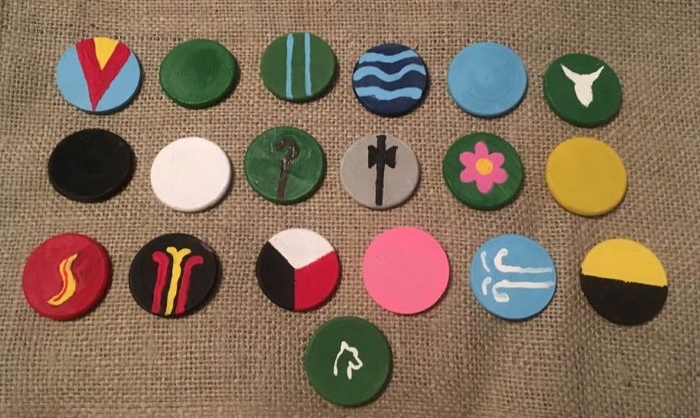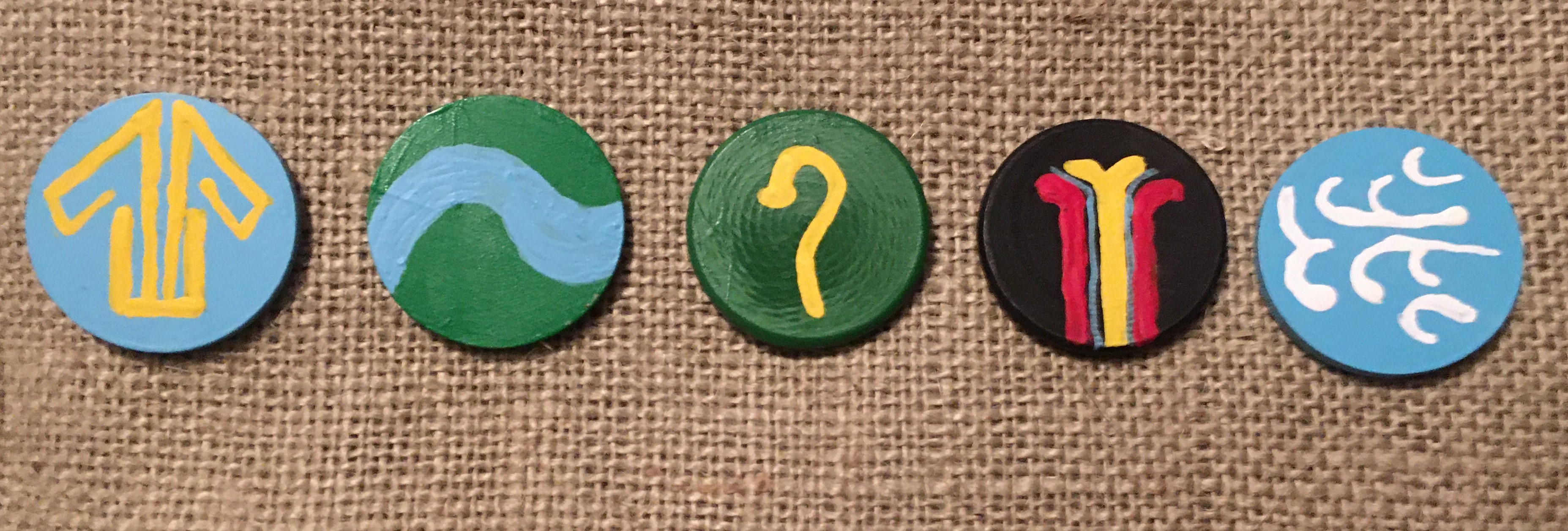I don't think that the Proto-Indo-Europeans used human-shaped deity images. It is possible, however, that they used abstract ones. If they did, we can't reconstruct what they were. If you wish to worship without them, that's fine. However, you might want to use some, either in ritual or in a home shrine. I've accordingly come up with suggestions for them, in several different forms. Remember, these are my own inventions, based on my undestanding of the Proto-Indo-European deities.
First column: Deity name
Second column: Abstract symbol
Third column: A bowl filled with something. Depending on what is used, it can be temporary (for the time of a ritual), or for a shrine.
Fourth column: A length of wood, about the width and thickness of a ruler, but longer. Home Depot and Lowe’s sell this size of board in various woods, such as oak. It can be stuck into the ground when outdoors, or in a pot filled with dirt, sand, pebbles, or glass beads when indoors. This size is also easy to carry; longer ones can be used for public rituals. An entire sacred space can be marked out by these, and left in place, with rituals in front of the appropriate ones. These symbols can also be painted on other things, such as wooden disks.
Fifth column: Either a long pole, for use in groups, or a short one, for personal work. Stakes are sold in garden stores that are both sizes and would work well. Poles are also sold in building supply stores which can be cut to length. The ribbons should be long enough to reach about half way down (or more for longer poles). The idea is to use at least three ribbons, folded in half and nailed through the center into the top of the stake. Guide holes are required for this, since it is extremely difficult to nail into the top of a stake. If more than one color or shade is used, remember that the first ribbon strung onto the nail will end up on top. Remember also when you are buying the ribbons that the length they hang down will be half that of the ribbon you buy.
| Deity |
General |
Bowl |
Stave |
Ribbons on Pole |
| Bhṛǵṇtyā́ |
Stone with light blue stripe from which a flame is descending; three flames; musical instrument, especially flute, especially a primitive one |
Beads: sky blue, red, yellow, orange; as many blue as the other colors together |
Light blue stripe with descending flame |
Sky blue, red, yellow, and orange; as much blue as the other colors together |
Dhéǵhōm Mā́tṛ |
Flat stone, perhaps painted with symbols of deep waters, earth, and grains; feminine-shaped stone: breasts, vulva; grains braided into a heavy stalk tied with green ribbon; two breast-shaped stones |
Dirt, sand, pebbles |
Green |
Brown and green |
| Diwós Sunú |
Two horses; two horses' heads; two horseshoes; images of ocean waves with white peaks |
Swan down, other water bird down, oats |
Two horses, two horses' heads |
Two poles, with one white, one black, and some yellow |
| Donu |
Water in a clear glass vial from local river or water source; stone from local water source painted with blue wavy lines |
River water |
Three blue wavy lines |
Blue and white |
| Dyḗus Ptḗr |
Eagle feather; three eagle feathers tied together with gold wire; gold wheel, possibly with eye image inside (perhaps on a pole); feathers from highest-flying birds of your area or ones you find along your travels; obelisk, in white or gold toned stone. Can rest on or be covered by a net, standing for the Xártus. |
Gold metal beads |
Light blue with sun in upper left |
Light blue and white |
| Gʷouwindā |
Cow horns; cow |
Milk |
Cow; cow's head; cow's horns |
White, black, and brown |
| Kolyos |
Goad; noose, hook; black stone, ideally one with a magnetic charge; scavenger animals: crow, raven, etc.; crow or raven feathers |
Dirt with dark stone |
Black |
Black |
| Mḗnōt |
White or silver disk; moonstone sphere;
time piece, hourglass |
White quartz pebbles |
White |
White |
| Páxusōn |
Bag of coins or pieces of valuable metals; goat; shepherd's crook; cross (symbol of crossroads); goat horns; goat fur or leather (other images can be put on this);
symbols of abundance; lantern (traveling to the unknown, guidance) |
Goat's milk, silver and gold beads; coins |
Shepherd's crook |
White, yellow, and red |
| Perkʷū́nos |
Stone hand axe; sharp piece of flint; mallet; iron or steel wheel (perhaps on a pole; if a wheel on a pole is also used for Dyḗus Ptḗr, that one should be higher than this one, with the wheel for Perkʷū́nos no higher than the hub of the one for Dyḗus Ptḗr); oak leaves, perhaps as a wreath; acorns; oak wood; stone arrowheads;
lightning symbols; bull, ideally bull with wheels on legs |
Iron beads; arrowheads |
Axe; hammer lightning symbols |
Black, grey, and white |
| Priyā |
Image of fruit tree in blossom; fruit tree wood; dried fruit tree flowers or roses; small gemstones in a square around a potted plant (walled space, gardens); vulva symbol; mirror; bouquet of red and/or pink roses in vase |
Red rose petals |
Red or pink wild rose flower; heart |
Red and pink |
| Sawélyosyo Dhugətḗr |
Yellow or gold disk on a pole; chariot with sun; ring/wreath with orange, gold, and yellow ribbons (should be kept near Diwós Sunú if they’re in a shrine together) |
Citrine |
Yellow, gold | ̄
Yellow |
| Wéstyā |
Fire, butter or oil lamp |
Clarified butter; red, yellow, and orange beads |
Flame on white circle |
Red, yellow, orange, and white |
| Xápōm Népōt |
Clear vial with water that’s had fire extinguished in it;
well; water vessel with candle in the center or floating candle |
Yellow and blue beads; Nektṛ, energy drink, Mountain Dew, ginger beer; spring water with lit candle floating in it |
Yellow and blue spiral or in fountain shape |
Yellow and blue |
| Xáryomēn |
Hoberman sphere; other structures of individual parts with connections, especially flexible ones; stone circle; grove or personal seal; braid of white, red, and black cords (three functions: white - priestly, red - warrior, black - producers); symbols of law, like the scales held by the goddess Justice. |
White, red, and black beads |
White, red, and black lines; triquetra; triskelion |
White, black, and red |
| Xáusōs |
Pole with copper rays; vase of roses in various shades of pink; birch wood, birch bark, half-circle of birch wood with ribbons |
Pink rose petals |
Square at top divided into black on top, pink on bottom; pink |
Variety of pinks on white stick |
| Əwḗtōs |
Wind chimes; 3D wind spinner; mobile; whirlilgig |
White and blue beads |
Breath symbols in white |
White and light blue (mostly white) |
| Yemós |
Skull (possibly with crown or gold wire(s)); black lantern; burial shroud; tomb image with spirals (maybe made into a candle holder); inverted cauldron; red and black woven rope hanging from ceiling; crow or raven feathers wrapped in gold wire |
Dirt with flame-colored stone, large golden bead, or a number of small golden beads |
Square at top divided into gold on top, black on bottom |
Black and red |
| Ɂeḱwonā |
Horse shoe; horse; Horse tail/hair |
Mead; horse's milk; kumis; oats |
Horse; horse head |
White and red (more white than red) |
This is a set of images I made on wooden disks bought from Michael's. They are in the same order as the table, except horizontal rather than vertical. I.e., the first row starts with Bhṛǵṇtyā́, the second with Kolyos, the third with Wéstyā, and with Ɂeḱwonā at the bottom.
 |
After I made the disks above I decided I wasn't happy with some of them, so I made new ones for those. I thought it would be good to keep the original picture and add a picture of the new ones so people could see some possibilities.
The order from left to right is the Diwós Sunú, Donu, Páxusōn, Xápōm Népōt, and Əwḗtōs. The earlier Donu was all about water, but Donu is a river goddess, not a water goddess. This one not only makes the river part clear, but, by showing the green land through which the river flows, depicts the nature of many of her descendants as Earth goddesses.
The earlier Diwós Sunú disk played to the twin aspect, and only a little bit to the connection with Dyḗus Ptḗr in the color of the stripes, which wasn't completely accurate, since they're his son, not him. I decided to instead use the Dyḗus Ptḗr light blue as a background, and then put two abstract horse heads in a sunshine yellow. The result is a bit Ukranian, but I like it.
I only made a slight modification to the Xápōm Népōt image. The original showed the fire coming up but not the water. So I just added two stripes for water.
I thought the Əwḗtōs disk looked a bit much like water. I think what I ended up with is more appropriate for wind.

|

|

|
|

 Main Page
Main Page  Proto Indo-European (PIE) Religion
Proto Indo-European (PIE) Religion  Wicca
Wicca  Mithraism
Mithraism  Ritual
Ritual  Tuadem
Tuadem 
 Back to the Beginnings
Back to the Beginnings  Nuit
Nuit  Dedicant's Program
Dedicant's Program  Prayers
Prayers  Suggested Reading
Suggested Reading  Suggested Links
Suggested Links 
 Paganism
Paganism  About Me
About Me  Publications
Publications  My Calendar
My Calendar  American Paganism
American Paganism  And The Rest
And The Rest 
 Contact Me
Contact Me 



